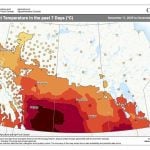It’s hard to believe we are already two months into 2023 and spring is right around the corner. It’s time for our look at last month’s weather and our look ahead to see what the latest long-term weather outlooks predict.
Thinking back on February’s weather, it was difficult to know whether it would turn out warmer than average, colder than average, or right around average as temperatures go. Maybe that’s because the month started off cold, then got nice and warm, then went back to cold before ending up with more mild weather.
Read Also

Farmer gift idea: How about a weather station?
The 2025 holiday season is looming, and a home weather station might make a great Christmas gift for farmers
I think the only thing everyone in Manitoba can agree upon about February’s weather was that it was a dry month. I don’t think I went for more than a day or two without overhearing someone talk about the lack of snow, especially compared to last winter.
How did the numbers add up? Overall, Alberta saw near-average temperatures in February. Both the Edmonton and Peace River regions saw temperatures running from 0.5 to 1 C warmer than average.
In the south, the Calgary region recorded a mean monthly temperature about 0.3 C colder than average. Precipitation, as you can see in this issue’s map, was near to above average in the south, above average in the west, below average in central regions and near average in the north.
Moving into Saskatchewan, we see a bit of a cooldown. The mean monthly temperature in Regina came in about 0.7 C below average, while in Saskatoon it was about 1.5 C colder than average. Precipitation was light, with Saskatoon reporting only 4.5 mm of water equivalent precipitation and Regina a measly 1.5 mm.
These slightly colder-than-average temperatures continued into Manitoba, mostly due to the really cold first three days of the month and a five-day cold snap that started Feb. 20. The coldest location compared to average was Brandon, with a mean monthly temperature of -14.8 C, 1.2 C below average. Winnipeg was the next coldest, with a mean monthly temperature of -14 C, about 0.8 C colder than average.
Dauphin was the “warm spot,” coming in at -13.9 C. While this was the absolute warm spot, it was actually the cold spot compared to average, at 1.3 C below that region’s long-term average.
Summarizing the month across the Prairies, it was a dry month with the exception of western and parts of northern Alberta. Temperatures, with the exception of southern Alberta, came in slightly below average across all regions.
While it was a colder-than-average February, it did not come close to some of the really cold months we have seen over the last couple of winters. If you do not recall, or have willfully blocked it from your mind, the last two Februarys saw mean monthly temperatures that were 6 to 9 C below average.
Who called it?
Now the fun part: which forecast came closest to the dry and slightly colder-than-average weather we saw in February?
I give the nod to either the CanSIPS model or my own forecast. The CanSIPS model called for slightly below average temperatures in February along with near average precipitation. So it got the temperature part right but was a little off on precipitation.
My forecast (or guess) was for near-average temperatures and below-average precipitation. I got the precipitation right but was a little off on the temperatures. I leave it up to you, but I call it a tie.
By the way, both almanacs called for a cold and snowy February, just saying.
Next up: what do the latest forecasts call for in the remainder of March and the first full month of spring — April?
We will start with the almanacs. The Old Farmer’s Almanac calls for a warmer- and wetter-than-average March followed by more of the same in April. The Canadian Farmers’ Almanac, when you read between the lines, appears to call for near- to maybe slightly above-average temperatures in March along with above-average precipitation.
April also looks like it will have near- to slightly below-average temperatures and above-average precipitation because the almanac mentions showers and stormy weather at least six times during the month.
Moving to the different weather models, starting with NOAA — and as usual, extrapolating northward because Canada magically does not exist to them.
They call for below-average temperatures over the western and central Prairies, with Manitoba possibly seeing near-average temperatures. Precipitation is forecasted to be around average. Actually, it forecasts us as having an equal chance of seeing either above- or below-average precipitation, and I take that as being average.
The CFS model is forecasting Manitoba will have near- to slightly above-average temperatures for the rest of March, with areas to our west at below-average temperatures. The warmer-than-average temperatures look to increase and spread westward in April, with our region forecasted to see temperatures about 2 C warmer than average.
The precipitation forecast is for near-average amounts in March followed by above-average amounts over southern and central Manitoba in April.
Looking at last month’s winner, the CanSIPS model forecasts colder-than-average temperatures in March, warming to above average in April. Precipitation will be near to slightly below average in March and April.
Last on the list is my weather guess. I am leaning toward a colder- and drier-than-average March, followed by a near- to slightly warmer-than-average April, at least across Manitoba, along with near-average precipitation.
As usual, we must sit back and see what Mother Nature will serve up this time round.
















